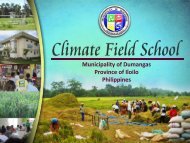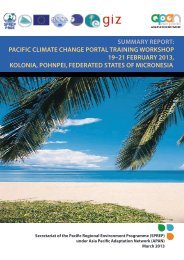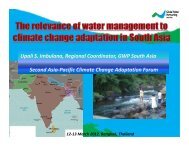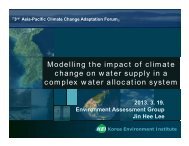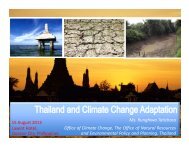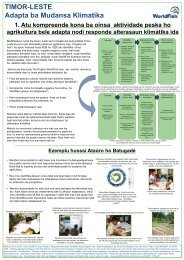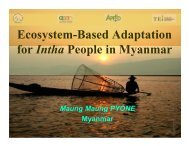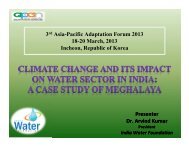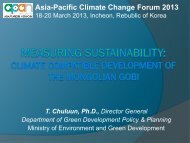PDF file (2.44 MB) - Asia Pacific Adaptation Network
PDF file (2.44 MB) - Asia Pacific Adaptation Network
PDF file (2.44 MB) - Asia Pacific Adaptation Network
Create successful ePaper yourself
Turn your PDF publications into a flip-book with our unique Google optimized e-Paper software.
24Parallel Sessions 2: Climage Change <strong>Adaptation</strong> and AgricultureThe role of irrigation in terms of mycotoxin and pathogenecity was studied. There were no differencesin the two types of irrigation in disease incidence; inoculated plants showed a 20% reduction inemergence under both irrigation types; and emergence slowed down under flooded conditions.Issues raised were: capacity for adaptation (lack of plant breeding in Costa Rica) which will affectrice production; need for varieties resistant to the pathogen; better adaptation to flooding and hightemperatures; and alternatives for crop rotation.Q: Is there any possibility of exploring collaboration with your neighbouring countries, e.g., Nicaraguaand Guatemala to address the issue regarding the lack of plant breeding?A: People from these countries raised the same issue. There are many biotechnologists in Latin Americabut they are not involved in the work of conventional plant breeders. There is definitely a possibilityfor collaboration; the big issue is organizing people and coordinating all these efforts.Q: Have you encountered other mycotoxins in rice in Costa Rica such as Aspergilla ?A: We do have those, but the focus of our research is on fumonisins. From the 2010 samples for twogrowing seasons, Fusarium was the most common fungus we found in rice.Comment: In the Philippines, Aspergelli is the most predominant in rice.Sustainable Ancient Water Managementand Resilience to Climate Change in Sri LankaRanjana U.K. Piyadasa, PhDSenior Lecturer, University of Colombo, Sri LankaSri Lanka has developed an ancient worldhydraulic (water) civilization which is made ofa network of thousands of manmade ancientlakes and ponds, known locally as 'tanks'. Usedin the dry zone of Sri Lanka for rice farming inancient times, the system is still being used atpresent. A ‘cascade’ is a connected series of tanksorganized within a micro- or meso-catchment ofthe dry zone landscape which is used to store,convey, and utilize water from a passing stream.This hydraulic system developed to its zenithduring the first millennium. It started to declinearound the 12 th century for reasons yet to be fullyunderstood.The study on the cascade system was conducted in the upper catchment of the Malwath Oya RiverBasin; the system used to consist of 14 tanks, now reduced to only eight. It aimed to identify currentwater availability for irrigation and agricultural sustainability and to re-establish and rehabilitate thetank system in the dry zone of Sri Lanka. The study concluded that the water, agricultural, ecological,and social management systems along with the cultural and spiritual norms that governed the tankcascade system has helped the rural communities to adapt to the impacts of climate change.International Conference on Climate Change Impactsand <strong>Adaptation</strong> for Food and Environmental SecurityConference Summary Report




